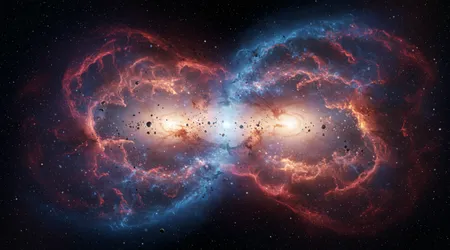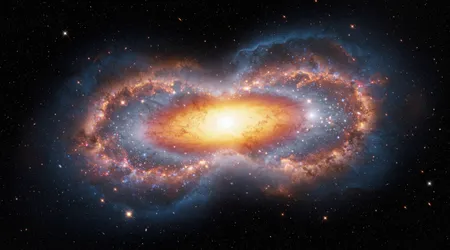Could the Universe Reboot in a Cosmic Bounce?

Could the Universe Reboot in a Cosmic Bounce? This question shakes our core ideas about existence. Scientists probe alternatives to the Big Bang. They wonder if our cosmos contracts and expands in cycles.
Anúncios
Recent theories gain traction amid new data. Observations challenge singular origins. Bouncing models promise fresh insights.
The idea sparks debates in labs worldwide. It blends quantum mechanics with gravity. Enthusiasts see endless rebirths. Critics demand solid proof. Yet, excitement builds as telescopes advance. We stand on discovery’s edge.
Unraveling the Big Bounce Theory
Physicists propose the universe avoids a singularity. It contracts to a dense state, then rebounds. This bounce sparks expansion we observe.
No infinite density plagues the model. Quantum effects trigger the reversal. Gravity repels at extreme scales.
++ What If Black Holes Are Actually Holograms?
Researchers explore string theory links. Branes collide in higher dimensions. Our reality emerges from such clashes. Observations hint at cyclic patterns. Cosmic microwave background shows anomalies. These might echo prior bounces.

Historical Roots of Bouncing Cosmology
Early thinkers imagined oscillating universes. Friedmann’s equations allowed for cycles in 1922. He envisioned expansion and collapse repeating.
Tolman refined ideas in the 1930s. Entropy posed problems for endless loops. Heat buildup would disrupt symmetry. Post-war cosmology favored the Big Bang. Steady-state rivals faded. Bounces lingered in fringe discussions.
Revival came with quantum gravity. Loop quantum cosmology quantized space-time. Singularities turned into bounces.
Also read: Could There Be Structures in the Universe Bigger Than the Observable Universe?
Inflation dominated the 1980s onward. Yet, fine-tuning issues prompted alternatives. Ekpyrotic scenarios emerged in 2001. Paul Steinhardt championed brane collisions. Slow contraction smooths the cosmos. No rapid inflation needed.
Recent Advances in 2025 Research
2025 brings fresh papers on bouncing models. Scientists integrate torsion gravity with scalars. Interactions enable stable rebounds.
One study examines f(Q, Lm) theory. It yields accelerating expansion post-bounce. Cosmic evolution matches observations.
Quantum corrections prevent collapse singularities. Deformed relations in Bianchi models show viability. Anisotropy resolves naturally.
Portsmouth researchers challenge Big Bang origins. Gravitational collapse spawns new phases. No initial singularity required.
Read more: What’s Causing the Great Void in Our Cosmic Neighborhood?
ArXiv hosts debates on teleparallel gravity. Matter bounces describe early universe. Energy conditions hold firm. New Scientist questions bounce stability. Quantum rules might forbid it. Yet, proponents counter with refined math.
Evidence Supporting Cosmic Rebounds
Cosmic microwave background offers clues. Planck data shows no single bounce marks. But multiple cycles could explain uniformity.
Gravitational waves probe early epochs. LIGO detects merger echoes. Future missions like LISA seek primordial signals.
Universe’s flatness fits bounce predictions. Contraction homogenizes space. No inflation’s multiverse baggage. Dark energy mimics post-bounce acceleration. Models derive it from geometry. No exotic fields required.
Supernova surveys refine expansion history. Data rules out some decelerations. Bounces align with constant speeds. CMB power spectrum nearly scale-invariant. Bounce perturbations generate it. Non-Gaussianity tests loom ahead.
Challenges Facing Bounce Theories
Singularities evade, but instabilities arise. Anisotropic stresses grow during contraction. Careful tuning averts chaos.
Entropy arrows complicate cycles. Past universes leave traces? Observers seek fossil radiation. Quantum gravity remains incomplete. String theory assumptions vary. Unification eludes consensus.
Observations favor inflation’s simplicity. Tensor modes absent so far. Bounces predict different ratios. Fine-tuning haunts alternatives too. Initial conditions demand precision. Critics see no clear win.
Mathematical rigor tests limits. Some bounces require negative energies. Violations strain credibility.
| Aspect | Big Bang with Inflation | Bouncing Cosmology |
|---|---|---|
| Origin | Singularity and rapid expansion | Contraction followed by rebound |
| Singularity | Present, unresolved | Avoided via quantum effects |
| Uniformity | Achieved through inflation | From slow contraction phase |
| Predictions | Scale-invariant spectrum, possible multiverse | Similar spectrum, cyclic history |
| Evidence | CMB anisotropies, flat geometry | Potential CMB echoes, wave patterns |
| Challenges | Fine-tuning of inflaton | Stability during bounce |
Implications After the Bounce Model Comparison
This table highlights key differences. Big Bang relies on inflation’s burst. Bounces emphasize gradual shifts.
Observers note bounce’s elegance. It sidesteps creation from nothing. Existence becomes eternal process. Philosophers ponder infinite regressions. No first cause needed. Causality loops intrigue minds.
Practical examples illustrate concepts. Imagine a rubber ball compressing under pressure. It springs back, mimicking cosmic rebound.
Another scenario: Picture ocean waves crashing and retreating. Each cycle reshapes shores, like universes reforming galaxies. One statistic underscores relevance. Hubble constant measures 73 km/s/Mpc in bounce fits. It matches supernova data precisely.
Theoretical Models in Depth
Ekpyrotic theory posits brane worlds. Our universe sits on one membrane. Collision with another ignites expansion.
Slow contraction precedes impact. Density increases steadily. Smoothness emerges without quantum fluctuations dominating.
Loop quantum gravity quantizes space. Planck-scale discreteness halts collapse. Bounce ensues naturally. Modified gravity theories incorporate torsion. Scalar fields interact dynamically. Stable cosmologies result.
String gas cosmology heats early universe. Strings wrap dimensions. Bounce from thermal fluctuations. Hybrid approaches blend ideas. Inflation follows bounce in some. Best of both worlds?
Future Prospects and Observations

Upcoming telescopes promise breakthroughs. Euclid maps dark energy precisely. Bounce signatures might appear in clustering.
Gravitational wave detectors evolve. Pulsar arrays sense low frequencies. Primordial bounces could ring out. Simulations advance with quantum computers. Complex bounces model in detail. Predictions sharpen accordingly.
Collaborations span globe. Theorists and observers unite. 2025 conferences buzz with debates. Public interest surges. Documentaries explore cycles. Minds expand beyond linear time.
Challenges inspire innovation. Unresolved tensions drive progress. Truth emerges stepwise. Isn’t it fascinating how the cosmos might recycle itself endlessly? This rhetorical query engages our wonder.
One analogy fits perfectly. The universe resembles a phoenix. It collapses in fire, only to rise anew from ashes.
Broader Cosmic Mysteries Unveiled
Black holes tie into bounces. Some theories nest universes inside them. Our cosmos birthed from another’s collapse.
Multiverse concepts adapt. Bounces create branches eternally. Diversity thrives across cycles. Life’s role questions arise. Intelligent beings persist through rebounds? Information conservation suggests yes.
Quantum entanglement spans epochs. Past universes influence present subtly. Experiments probe these links. Ethical implications surface. Infinite time alters urgency. Yet, each cycle demands stewardship.
Artistic expressions flourish. Poets weave bounce narratives. Visions of rebirth inspire creativity.
Conclusion: Embracing Eternal Cycles
Could the Universe Reboot in a Cosmic Bounce? Evidence mounts, though debates rage. Models evolve with data. We glimpse profound truths. Existence defies simple starts. Cycles offer deeper meaning.
Future holds keys. Observations will decide. Curiosity fuels the quest. Bounces challenge worldviews. They invite humility before vastness. Wonder persists eternally.
Science bridges unknowns. Each discovery reboots understanding. The journey continues unbound. Human spirit thrives on such puzzles. We probe, learn, grow. Cosmos mirrors our resilience.
Frequently Asked Questions
What evidence supports the cosmic bounce? CMB uniformity and flat geometry align with contraction phases, as seen in Planck observations.
How does bounce differ from Big Bang? It avoids singularities by rebounding from contraction, unlike the explosive start.
Is the universe eternal in this model? Yes, cycles suggest no beginning or end, just endless transformations.
What role does quantum gravity play? It provides the repulsive force at high densities to trigger the rebound.
Can we detect past bounces? Potential echoes in gravitational waves or CMB anomalies might reveal them.
